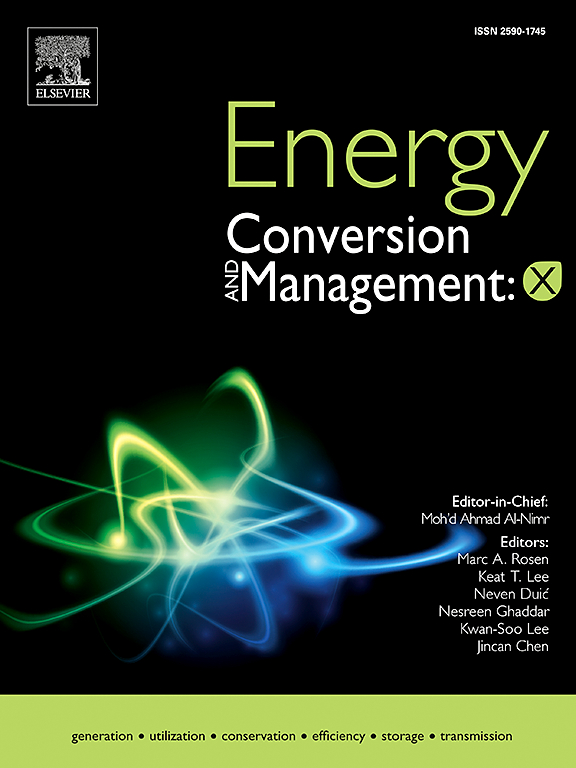Nuclear-based combined heat and power industrial energy parks − application of high temperature small modular reactors
IF 7.1
Q1 ENERGY & FUELS
引用次数: 0
Abstract
This study identifies industries that are well-suited for replacing or supplementing existing process heating facilities with nuclear power to reduce GHG emissions. Three criteria are considered in selecting target industries: energy demand, applicability of heat from nuclear energy, and the operating principles of the industries. This study also investigates the role of thermal energy storage (TES) in enhancing the integration of nuclear systems within industrial energy parks, exploring its impact on various industrial processes such as chemical plants, oil refineries, and steel production facilities. The novelty of this work lies in its comprehensive examination of TES integration between the nuclear primary loop and the steam cycle, ensuring that system performance is not compromised. This research goes beyond previous efforts by demonstrating the potential for moderate-temperature nuclear heat to replace fossil-based systems in many industries, while highlighting the challenges of meeting high-temperature demands. The study utilized a two-tank molten-salt TES system to provide flexible combined heat and power (CHP) to an industrial energy park, where diverse thermal and electric demands are integrated. A case study shows that TES integration can significantly reduce reliance on natural gas boilers by 9%-77% and decrease dependence on external grids, achieving substantial internal electricity supply. The economic analysis revealed the cost-optimal trade-offs of Nuclear-TES-CHP systems when integrated with existing natural gas boilers in the industrial plant. This study emphasizes the critical role of TES in achieving decarbonization goals, positioning it as an essential element for future industrial energy solutions.
核能热电联产工业能源园区——高温小型模块化反应堆的应用
这项研究确定了非常适合用核电取代或补充现有过程加热设施以减少温室气体排放的行业。在选择目标行业时考虑了三个标准:能源需求、核能热的适用性和行业的运作原则。本研究亦探讨热能储存(TES)在加强工业能源园区内核系统整合方面的作用,探讨其对各种工业过程(如化工厂、炼油厂和钢铁生产设施)的影响。这项工作的新颖之处在于它对核一次回路和蒸汽循环之间的TES集成进行了全面检查,确保系统性能不受影响。这项研究超越了以往的努力,展示了中温核热在许多行业取代化石燃料系统的潜力,同时强调了满足高温需求的挑战。该研究利用双罐熔融盐TES系统为工业能源园区提供灵活的热电联产(CHP),该园区集成了多种热电需求。案例研究表明,TES集成可以显著减少对天然气锅炉9%-77%的依赖,减少对外部电网的依赖,实现大量的内部电力供应。经济分析揭示了核- tes - chp系统与工业厂房现有天然气锅炉集成时的成本最优权衡。本研究强调了TES在实现脱碳目标中的关键作用,将其定位为未来工业能源解决方案的基本要素。
本文章由计算机程序翻译,如有差异,请以英文原文为准。
求助全文
约1分钟内获得全文
求助全文
来源期刊

Energy Conversion and Management-X
Multiple-
CiteScore
8.80
自引率
3.20%
发文量
180
审稿时长
58 days
期刊介绍:
Energy Conversion and Management: X is the open access extension of the reputable journal Energy Conversion and Management, serving as a platform for interdisciplinary research on a wide array of critical energy subjects. The journal is dedicated to publishing original contributions and in-depth technical review articles that present groundbreaking research on topics spanning energy generation, utilization, conversion, storage, transmission, conservation, management, and sustainability.
The scope of Energy Conversion and Management: X encompasses various forms of energy, including mechanical, thermal, nuclear, chemical, electromagnetic, magnetic, and electric energy. It addresses all known energy resources, highlighting both conventional sources like fossil fuels and nuclear power, as well as renewable resources such as solar, biomass, hydro, wind, geothermal, and ocean energy.
 求助内容:
求助内容: 应助结果提醒方式:
应助结果提醒方式:


